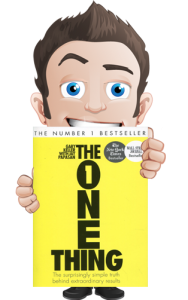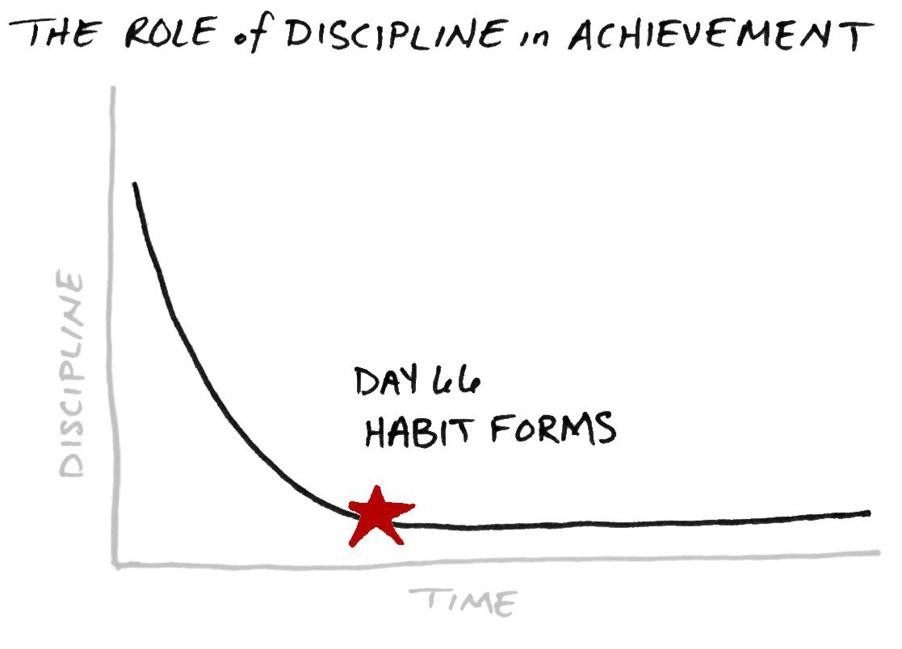The One Thing Definitive Book Summary
by Gary Keller & Jay Papasan
The Surprisingly Simple Truth Behind Extraordinary Results


Overview
The One Thing – When You Want The Absolute Best Chance To Succeed At EVERYTHING
‘The One Thing’ is one of my favorite books. There are so many golden nuggets and lessons that you can use to improve just about every aspect of your life (in just 1 day).
The best part?
You don’t have to read the whole book, as I cover everything you need to know in our in-depth Chapter-by-Chapter Summary and walk you through the step-by-step strategy in the comprehensive bite-size summary.
Ready?
Let’s dive right in…
The One Thing Book Review – A Comprehensive Summary
Here’s a question that we’d all like the answer to:
“What’s the one thing you could do that would make everything else easier or unnecessary?”
Why do we ask this? Why do we have to ask this?
Fundamentally, it’s because we feel we don’t have enough time and therefore distribute our resources so thinly, we end up achieving little or nothing.
In their book “The One Thing”, Gary Keller and Jay Papasan reveal that successful people go small. They don’t try to do everything; they focus on the one activity that brings the most reward. They ignore all they could do, and focus on what they should do.
Lesson 1
The Myth of To-Do lists!
Let’s look at success. The route to it is challenging and it’s not the same for everyone. If it were, then bookshops would only need to stock one book in their personal development section!

The same goes for taking action. Different actions have different consequences and different success rates.
So how do we decide what to do? How do we make good decisions?
One thing the authors are adamant about is the fact that knocking out a hundred tasks for whatever reason is a poor substitute for doing even one task that’s meaningful. Having a full and comprehensive task list is a burden. It fills our day with unimportant things.
Being busy is not the same as being productive and successful.
In this One Thing book review you will learn that Keller and Papasan suggest that instead of a to-do list we need to have a success list — a list purposefully created around extraordinary results.
What is a success list?
Let’s look at the 80/20 rule – also known as the Pareto principle.
What a success list is is basically the Pareto principle on steroids.
Take the 20% and apply Pareto again. Repeat and repeat again until only One Thing is left on your list. THAT’S the task you should be doing.

Before we get stuck into that task, there’s another key myth that needs to be busted: multitasking doesn’t work!
Think of it this way. We have two identical “progress cars” but only enough dollars for one tank of “progress gas”. Do we fill one or both? Filling both and setting off in the direction of our ambition gets us halfway with each.
Alternatively, we can comfortably reach our destination by using just the one car.
As the authors point out: “You can do two things at once, but you can’t focus effectively on two things at once.”
“Every time we try to do two or more things at once, we’re simply dividing up our focus and dumbing down all of the outcomes in the process.”
Shane Stamford Tweet
Lesson 2
The Myth of Discipline and Willpower
The next two myths to shatter are characteristics often admired in successful people: discipline and willpower.

Discipline is not a noun; it’s a verb. It’s something we do — not something we have. In simple terms, discipline is a beneficial habit.
When we see people, who look like “disciplined” people, and what we’re really seeing is people who’ve fashioned a handful of positive habits into their lives.
This makes them seem “disciplined”, when actually they’re not. No one is. Despite what you may have read, it takes on average 66 days to form a habit. Use your willpower to develop long-term habits.

The fact is, we can become successful with less discipline than we think. Success is about doing the right thing, not about doing everything right. You nee to make doing the right thing a habit.
Remember our “progress gas”? Well, our “progress car” is dual-fueled. It also runs on willpower.
Every morning we start out with a full tank. As the day goes on, it reduces every time we draw on it. As the tank depletes, so does our resolve and when it’s empty… we’re done.
When our willpower runs out, we revert to our default fuel. Blood, Sweat, and Tears.
The Point?
Willpower is not infinite. Use it with care. If we want to get the most out of our day, we need to do our most important work — our ONE Thing — early, before our willpower is drawn down.
Lesson 3
The myth of Work-Life balance
Here’s a work-life balance history lesson, courtesy of the authors.

200 years ago, the village blacksmith didn’t have to stay at the forge until 5 P.M.; he could go home when the horse’s feet were shoed.
Only after the Industrial Revolution introduced the concept of large numbers working for someone else, did the concept of work-life balance arise.
Now in the 21st century, we strive for that elusive ratio. It’s a myth. Work-life balance does not support success.
The whole concept of balance is to create equality between two extremes. Balance brings average, and average means… well, average.
Magic never happens in the middle; magic happens at the extremes.
If we want to succeed, a balanced life cannot be achieved.
We need to focus on One Thing and lean in its direction – maybe for up to 10,000 hours, if we are to believe Malcolm Gladwell.
The question of balance is a question of priority. When we act on our priority, we automatically go out of balance, giving more time to our One Thing over everything else.
Lesson 4
Finding your One Thing
So how do we bring it all together? How do we find that One Thing?

According to the authors we need to ask the Focusing Question:
What’s the one thing I can do such that, by doing it, everything else will be easier or unnecessary?
Shane Stamford Tweet
Of all The One Thing book quotes, we can break this one down into three parts…

PART ONE: “WHAT’S THE ONE THING I CAN DO…” – This tells us that the answer will be one option from many. It directs us to be specific. The last phrase “can do” is our call to action.
PART TWO: “… SUCH THAT, BY DOING IT …” – This tells us there’s a standard our answer must meet. “Such that, by doing it” ensures our actions will lead to positive outcomes.
PART THREE: “… EVERYTHING ELSE WILL BE EASIER OR UNNECESSARY?” – This assures us that good things will come.
To make it more specific, we can merely reframe the Focusing Question by inserting our area of focus or introduce a time frame — such as “right now” or “this year”.
For example: “For my job, what’s the ONE Thing I can do to ensure I hit my goals this week such that, by doing it, everything else will be easier or unnecessary?”
The authors believe that the Focusing Question is the greatest question we can ask ourselves.
But…
The challenge of asking a Great Question is that, once we’ve asked it, we’re faced with finding a Great Answer.
Answers come in three categories:
- Doable;
- Stretch;
- Possibility.
Doable: The easiest answer is the one that’s already within reach of our knowledge, skills, and experience. We know can do it.
Stretch: The next level up is a “stretch” answer. While this is still within our reach, it can be at the farthest end of our ability.
Possibility: But if we want the most from our answer, we must realize that it lives outside our comfort zone. A possible answer exists beyond what is already known and being done. A new answer.
The authors, however, remind us that achievement of our One Thing is not without difficulty.
If we lack a “big picture” view, we can quickly fall into promiscuous objectives. In other words, once we get what we want, our happiness wanes because we quickly become accustomed to what we acquire. New objectives then become more attractive.
Having purpose helps us. Knowing why we’re doing something provides the motivation needed to keep things going when things don’t quite go right.
What’s the thing that gets you up in the morning and keeps you going when you’re tired and worn down?
That’s purpose.
Live with purpose, and we’ll know where we want to go.
Live by priority, and we’ll know what to do to get there.
Purpose without priority is powerless. We need to set and prioritize our goals.
So, let’s see how the focusing question, together with purpose and priority, creates a plan.
Here’s how it goes:
The five-year view: Based on my ‘someday’ goal, what’s the ONE Thing I can do in the next five years to be on track to achieve it?
The annual view: Based on my five-year goal, what’s the ONE Thing I can do this year to be on track to achieve my five-year goal, so that I’m on track to achieve my ‘someday’ goal?
The monthly view: Based on my goal this year, what’s the ONE Thing I can do this month, so I’m on track to achieve my goal this year, so I’m on track to achieve my five-year goal, so I’m on track to achieve my someday goal?
The weekly view: Based on my goal this month, what’s the ONE Thing I can do this week so I’m on track to achieve my goal this month, so I’m on track to achieve my goal this year, so I’m on track to achieve my five-year goal, so I’m on track to achieve my someday goal?
The daily view: Based on my goal this week, what’s the ONE Thing I can do today so I’m on track to achieve my goal this week, so I’m on track to achieve my goal this month, so I’m on track to achieve my goal this year, so I’m on track to achieve my five-year goal, so I’m on track to achieve my someday goal?
The immediate One Thing: So, based on my goal today, what’s the ONE Thing I can do right NOW so I’m on track to achieve my goal today, so I’m on track to achieve my goal this week, so I’m on track to achieve my goal this month, so I’m on track to achieve my goal this year, so I’m on track to achieve my five-year goal, so I’m on track to achieve my someday goal?
And that’s how you get from lofty vision to pragmatic next steps.

And now I’d like to hear from you:
What’s your ONE thing that will deliver exceptional results for your life?
Or maybe you have a question.
Either way, feel free to leave your comments below and I’ll make sure to answer as soon as they come in.


